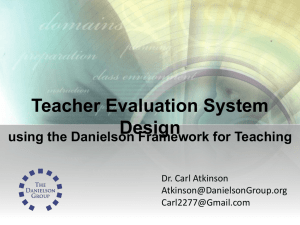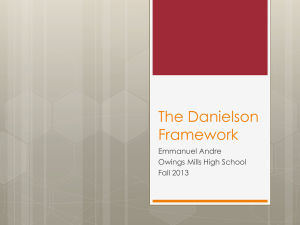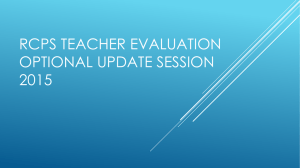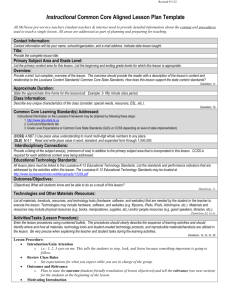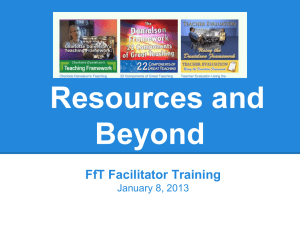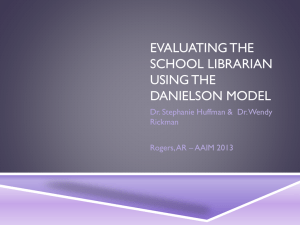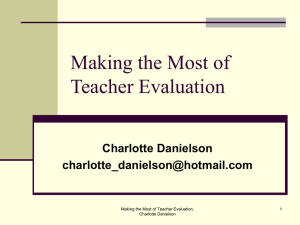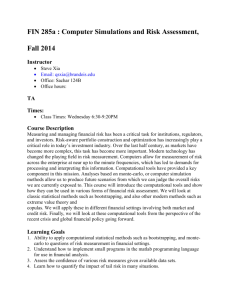File - Baldwin High School Professional Development
advertisement
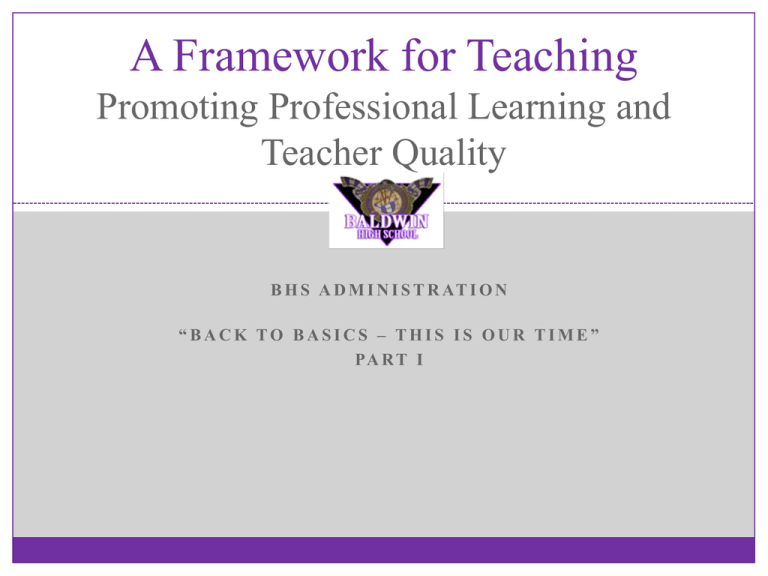
A Framework for Teaching Promoting Professional Learning and Teacher Quality B H S A D M I N I S T R AT I O N “BACK TO BASICS – THIS IS OUR TIME” PA R T I Today’s Agenda Teachers Are Like Gardeners Defining Effective Practice: A Framework for Teaching – Charlotte Danielson Standards Aligned System (SAS) Danielson Group Teaching Makes the Difference 3 “The most important factor affecting student learning is the teacher….. an influence many times greater than poverty or per-pupil expenditures.” Sanders, Wright and Horn 1997 “The effect of increases in teacher quality swamps the impact of any other educational investment, such as reductions in class size.” Goldhaber, 2009 A Road Map…. Because teaching is complex, it is helpful to have a road map through the territory, structured around a shared understanding of teaching. Charlotte Danielson Defining Effective Practice In order to create the conditions for improved teaching, one must first define it. Without such a definition of good practice, educators are, in effect, wandering in a swamp. Charlotte Danielson A Framework for Teaching: Components of Professional Practice Domain 1: Planning and Preparation Domain 2: The Classroom a. Demonstrating knowledge of content Environment and pedagogy PLANa. Creating an environment of respect b. Demonstrating knowledge of students and rapport c. Setting instructional outcomes b. Establishing a culture for learning d. Demonstrating knowledge of resources c. Managing classroom procedures e. Designing coherent instruction d. Managing student behavior TEACH APPLY f. Designing student assessments e. Organizing physical space Domain 4: Professional Domain 3: Instruction Responsibilities a. Communicating with students a. Reflecting on teaching b. Using questioning and discussion b. Maintaining accurate records techniques REFLECT c. Communicating with families c. Engaging students in learning d. Participating in a professional d. Using assessment in instruction Community e. Demonstrating flexibility and e. Growing and developing professionally responsiveness f. Demonstrating professionalism Danielson 2007 SAS / Danielson Group websites Charlotte Danielson domain rubrics Danielson Group SIX “Pros” for Teacher Evaluation 8 1. System is based upon a defensible definition of teaching 2. Procedures are differentiated 3. Evidence anchors the process 4. Promotes teacher learning 5. Transparency 6. Inner-Rater Reliability Final Comments 9 Deck of Cards A Framework for Teaching Promoting Professional Learning and Teacher Quality B H S A D M I N I S T R AT I O N “BACK TO BASICS – THIS IS OUR TIME” PA R T I I Agenda Elements of Effective Teacher Evaluation New Teacher Evaluation System Teacher Self-Assessment rubrics Professional Growth Meetings Charlotte Danielson Resources Charlotte Danielson domain rubrics Danielson Group Performance Levels: Key Words 13 Unsatisfactory Unsafe Lack of Unaware Harmful Unclear Poor Unsuitable None Basic Proficient Distinguished Performance Levels: Key Words 14 Unsatisfactory Basic Unsafe Lack of Unaware Harmful Unclear Poor Unsuitable None Partial Generally Inconsistently Attempts Awareness Moderate Minimal Some Proficient Distinguished Levels of cognition and constructivist learning increase Performance Levels: Key Words 15 Unsatisfactory Basic Proficient Unsafe Lack of Unaware Harmful Unclear Poor Unsuitable None Partial Generally Inconsistently Attempts Awareness Moderate Minimal Some Consistent Frequent Successful Appropriate Clear Positive Smooth Most Distinguished Levels of cognition and constructivist learning increase Performance Levels: Key Words 16 Teacher-directed success! Student-directed success! Unsatisfactory Basic Proficient Distinguished Unsafe Lack of Unaware Harmful Unclear Poor Unsuitable None Partial Generally Inconsistently Attempts Awareness Moderate Minimal Some Consistent Frequent Successful Appropriate Clear Positive Smooth Most Seamless Solid Subtle Skillful Preventative Leadership STUDENTS Always Levels of cognition and constructivist learning increase Danielson’s Levels of Performance 17 Unsatisfactory The teacher does not yet appear to understand the concepts underlying the component. Working on the fundamental practices associated with the standards will enable the teacher to grow and develop in this area. Basic The teacher appears to understand the concepts underlying the component and attempts to implement its standards. But implementation is sporadic, intermittent, or otherwise not entirely successful. Additional reading, discussion, visiting classrooms of other experienced teachers will enable the teacher to become proficient in this area. Proficient The teacher clearly understands the concepts underlying the component and implements it well. Most experienced, capable teachers will regard themselves and be regarded by others as performing at this level. Distinguished Teachers at this level are master teachers and contribute to the field, both in and outside their school. Their classrooms operate at a qualitatively different level, consisting of a community of learners, with students highly motivated, engaged and assuming considerable responsibility for their own learning. Using the Levels of Performance 18 What are some ways teachers Lesson planning can use the levels of Self assessment performance to promote their Developing professional learning and growth? learning goals Reflecting on teaching and learning Talking about teaching FAQ’S: PA New Teacher Evaluation 19 What is PSEA’s role in developing the new system? PSEA has been a highly vocal presence on this committee and has been particularly active in advocating for a system that is valid, reliable, and fair. What specific measures of “student growth” will be a part of the new system? PDE envisions a menu of several measures that could be used to measure “student achievement and growth,” depending upon individual teachers’ grade level and content area assignment. How much will “student growth” count in a final teacher evaluation? Department and legislature seem to be gravitating toward counting multiple measures of student achievement and growth as up to 50 percent of a teacher’s individual evaluation result, but no final decision has been made. What will happen to other PDE-approved teacher evaluation systems once the new system is developed? PSEA anticipates that the new system will replace current PDE evaluation forms 426, 427 and 428 systems. Evidence: JUST THE FACTS! Evidence is a factual reporting of events. It may include teacher and student actions and behaviors. It may also include artifacts prepared by the teacher or students. It is not clouded with personal opinion or bias. BHS Updated Walkthrough Look-Fors Instructional Delivery: What is the teacher doing? Posted learning objectives and activities Whole class instruction- Lecturing, Explaining Higher order questions Knowledge/Comprehension questions Appropriate wait-time for student responses Modeling Guided Practice Checking for understanding Sustaining student feedback Seamless transition from one topic to another Closure: Student Centered Student Engagement: What are the students doing? Percent engaged with instruction Following teacher directions Responding to teacher questions Actively participating in activities or discussion Working in groups or with partners Working alone, silently to complete tasks Writing open-ended responses Completing a worksheet Listening to teacher Student presentations Using technology or media 5501 Formal Observation Language Category I: Personality = Domain 4 Professional Responsibilities Category II: Preparation = Domain 1 Planning and Preparation Category III: Technique = Domain 3 Instruction Category IV: Pupil Reaction = Domain 2 Classroom Environment Teacher Self-Assessment and Professional Growth Plan 23 This plan is recommended so that teachers as professionals understand their areas of strengths and areas for improvement. The following procedures are recommended for teacher self-assessment: 1. Review of the Framework for Effective Teaching that will be utilized for evaluation of performance. 2. Rate your performance for each element in the four domains using the rubrics of the framework. (Framework Rubrics) 3. Identify areas of strength. 4. Identify areas of performance where there is recognition of need for improvement. 5. Make an analysis of the reasons for needed improvement. 6. Identify 1 specific goals per domain that would result in an improved performance. 7. Danielson Self-Reflection Rubrics / Growth Plan (Common I drive) Professional Growth Plan Meeting 24 Purpose: Allow the teacher and the principal to become oriented to the evaluation process. Provide the teacher and the administrator with the opportunity to discuss the teacher’s effectiveness in terms of the framework. Engage in professional dialogue and trust development. The following are meeting procedures and guidelines: 1. The teacher and administrator review the evaluation cycle. 2. Teacher and administrator discuss the teacher’s understanding and effectiveness in terms of the Framework for Effective Teaching. 3. The teacher will share his/her performance goals. Suggestions and direction will be given in terms of the framework and teacher growth. 4. Evaluation activities are discussed and scheduled. 5. The Professional Growth Plan Meeting form is completed and signed. Professional Growth Calendar 25 Domain 1 September / October • Professional Development • PG meetings • Walkthroughs November / December • Professional Development • PG meetings • Walkthroughs January / March • Professional Development • PG meetings • Walkthroughs April / May • Professional Development • PG meetings • Walkthroughs Planning and Preparation Domain 2: Classroom Environment Domain 3: Instruction Domain 4: Professional Responsibilities Thank You 26 Questions???

